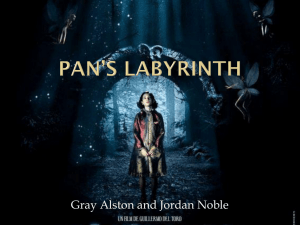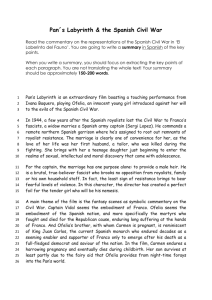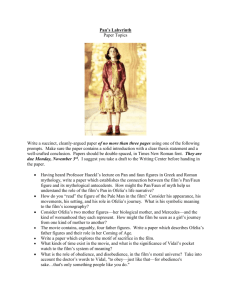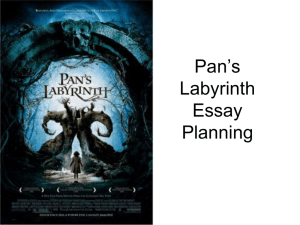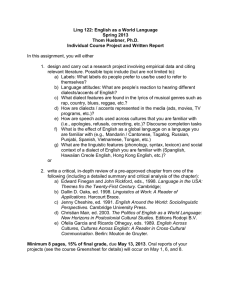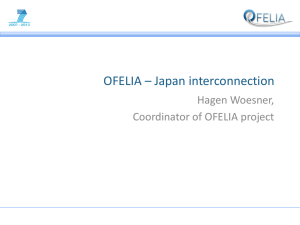PANS LABYRINTH PP (2)
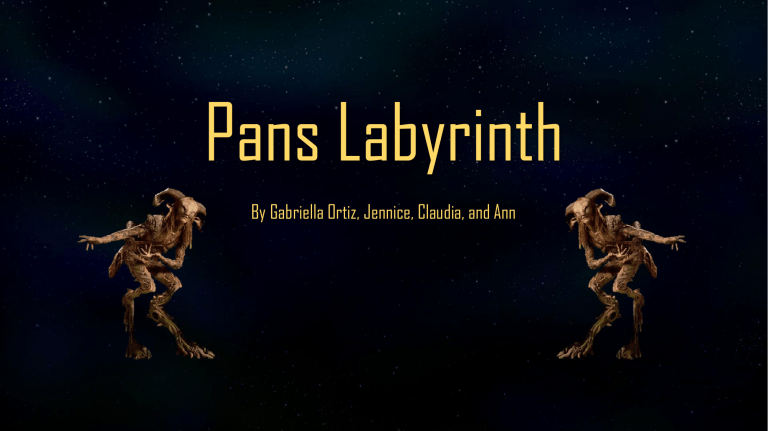
Pans Labyrinth
By Gabriella Ortiz, Jennice, Claudia, and Ann
Time and place that film takes place (Q#1)
• …………………………………………………………………………
………………………………………………………………………….
• TAKE AS MANY SLIDES YOU NEED FOR ANSWERING THIS QUESTION
The psychological aspects
•
Pans Labyrinth is chock-full of psychological elements. These elements are portrayed through various forms of symbolism throughout the film.
The Imaginary Stage
•
French psychiatrist Jacques Lacan proposed a theory of childhood development that he called the imaginary stage. This stage is characterized by the connection of mother and child. The child is said to be “one with the mother”.
Ofelia exhibits this stage throughout the movie until her mother’s death.
The Imaginary Stage
•
Ofelia is often shown
•
Clutching onto her mother
•
Sleeping with her mother
• Discussing her mother’s great beauty
• Finding comfort in her mother’s voice
All of these tendencies indicate the deep connection that Ofelia shares with her mother.
Defense Mechanism
•
Psychiatrist, George Eman Valliant developed a four level classification system of defense (coping) mechanisms.
•
Level I: The psychotic defenses
(delusional projection and distortion)
•
Level II: The immature defenses
(schizoid fantasy)
Defense Mechanism Level I
•
Delusional Projection: Ofelia has delusions about her external reality.
Ex. Ofelia believes that a mandrake root will save her mother from her pregnancy related ailment.
•
Distortion: Ofelia exhibits distortion when she begins to reshape her external reality to meet her internal needs.
Ex. Ofelia creates fantastical events to shield herself from the grim reality she is facing.
Defense Mechanism Level II
•
Schizoid Fantasy: Ofelia shows a tendency to resolve external conflicts through fantasy.
Ex. Ofelia copes with the death of her father by believing that she will be reunited with him if she does everything that the faun asks her to do.
Freud’s Personality Theory
• Sigmund Freud believes that the psyche was divided into three parts.
• Id: Instinctive and impulsive part of the psyche
• Ego: The part of the psyche that mediates the Id with reality and works through reason
• Superego: Functions to control the Id’s impulses
Freud’s Personality Theory
•
The pale man scene best represents
Freud’s theory
•
Once she enters the dungeon, Ofelia retrieves the dagger and makes her way out. Until her Id gets the best of her and she impulsively eats a grape.
•
As the pale man awakens, so does her superego.
•
Her ego tells her to run away to safety.
Symbolism
• Like any other great movie, Pan’s Labyrinth is full of symbolism
The Tree
•
Tree resembles the uterus.
•
It is representative of the mother’s reproductive system.
•
It symbolizes the mother’s slow approach to death.
The Toad
•
The toad symbolizes
Ofelia’s unborn brother.
•
The tree is dying because the toad inhabits it.
•
The toad is to the tree as the baby is to the mother.
Ofelia’s Book
• Ofelia’s Book of the Crossroads is another symbol of her mother’s fatal pregnancy.
•
Her book depicts a uterus shaped image become a botched version of itself.
•
The picture is in red ink, symbolizing the bloodshed that the pregnancy lead to.
